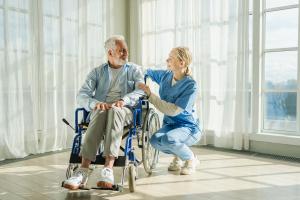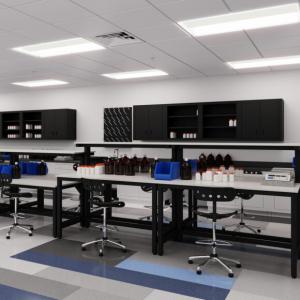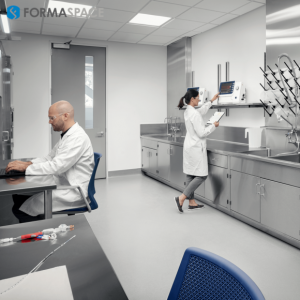New Neurotherapy Techniques Cah Help Paralyzed Patients Walk Again
Learn about new therapies from Grégoire Courtine's laboratory research that are helping those suffering from paralysis to live better lives.
Courtine and other research partners have published papers outlining their approach to helping paralytic patients restore muscle control through the implantation of two stimulator medical devices.”
AUSTIN, TX, UNITED STATES, August 7, 2024 /EINPresswire.com/ -- A video of a paralyzed man stepping up out of a wheelchair to take steps on his own has given members and friends of the disabled community hope.— Formaspace
In this Formaspace executive report, we’ll investigate the need for new therapies to help those suffering from paralysis to live better, more independent lives.
The Number of Americans Suffering from a Paralysis Diagnosis May Be Higher than You Think
The US disabled community is estimated to be around 42 million people, about 13% of the population. Among this group, disability due to some form of paralysis affects about 5.4 million people, representing around 1.6% of the population.
The community of those affected by paralysis can be categorized further:
Some paralytics may have conditions (such as congenital paraplegia) that affect their nervous system during fetal development. Others may have diseases or injuries detected at birth or diagnosed during infancy that affect muscle control, such as spina bifida or cerebral palsy.
At the other end of the demographic spectrum are diseases that typically onset later in life, such as a stroke, multiple sclerosis, or Parkinson’s, all of which can result in varying degrees of paralysis.
Accidents that injure the brain or the spinal cord are the third main category of paralysis causation. Accidental falls (such as from high ladders and roofs or during sporting events, including skiing or horseback riding), vehicular accidents, gunshot or knife wounds, or nerve damage incurred during surgical procedures (such as back surgery) can all lead to varying degrees of paralysis.
According to a 2013 study, stroke is the most common cause of paralysis (37%), followed by spinal cord injuries (27%), multiple sclerosis (18%), and cerebral palsy (8%).
Understanding the Differing Classifications of Paralysis and Related Medical Conditions
The nervous system, controlled by the brain, sends signals down the spinal cord to different muscle groups. Depending on how a disease or injury manifests itself, there can be different outcomes:
Monoplegia affects one limb only.
Diplegia affects the body symmetrically (for example, both arms or both sides of the face)
Hemiplegia, typically caused by a stroke, affects one side of the body.
Paraplegia affects from the waist down, typically affecting both legs and possibly bowel/bladder control and sexual function.
Quadriplegia affects all four limbs. (Tetraplegia additionally affects the neck.)
Locked-in syndrome, a rare condition, affects all movement except the eyes.
In addition to the conditions listed above, paralysis can lead to significant complications, including muscular atrophy, breathing problems, bedsores, blood clots (including deep vein thrombosis or DVT), persistent high or low blood pressure, and problems with speech or swallowing.
Grégoire Courtine, Champion of Paralytics Research
The French researcher Grégoire Courtine has emerged as a leading figure in the fight to understand the underlying causes and reverse the symptoms of paralysis.
Educated in a joint PhD program at the University of Pavia and the University of Burgundy, Courtine (who is often addressed as “G”) performed his postdoc work at UCLA before moving to the University of Zurich in 2008 to study paraplegic rats.
In 2012, Courtine took a position with the École Polytechnique Fédérale de Lausanne (EPFL), eventually establishing his own research laboratory, known as the G-LAB.
In 2019, Courtine and his research student Léonie Asboth published a major paper on their experiments with paralyzed rats that theorized the brain could be reprogrammed to use alternate pathways, essentially allowing signals to bypass severed nerve connections to reach paralyzed muscle groups.
Courtine co-founded a commercial biotech venture, ONWARD Medical, in 2014, whose mission is to bring the neurostimulation therapies developed at G-LAB to market. (You can read the ONWARD pitch deck here.)
The neurosurgeon Jocelyne Bloch, who joined EPFL as an adjunct professor in 2019, joined Courtine in a joint co-director leadership role at the .NeuroRestore Laboratory – a cooperative initiative run by the Defitech Foundation, the Lausanne University Hospital, the University of Lausanne and the EPFL.
The .NeuroRestore Laboratory conducts (and evaluates) surgical implantations of medical devices for brain and muscle stimulation therapy in volunteer patients.
The Latest Paralytic Therapeutic Research from G-LAB, .NeuroRestore and ONWARD
In the last few years, Courtine and other research partners have published a series of papers outlining their evolving approach to helping paralytic patients restore some degree of muscle control through the implantation of two stimulator medical devices, one located in the brain and one in the affected muscle group:
“Spinal Cord Repair: Advances in Biology and Technology.” Nature Medicine 25, no. 6 (June 2019): 898–908. https://doi.org/10.1038/s41591-019-0475-6.
Read more...
Julia Solodovnikova
Formaspace
+1 800-251-1505
email us here
Visit us on social media:
Facebook
X
LinkedIn
Legal Disclaimer:
EIN Presswire provides this news content "as is" without warranty of any kind. We do not accept any responsibility or liability for the accuracy, content, images, videos, licenses, completeness, legality, or reliability of the information contained in this article. If you have any complaints or copyright issues related to this article, kindly contact the author above.



